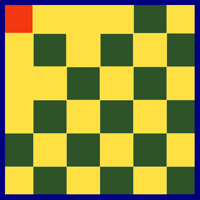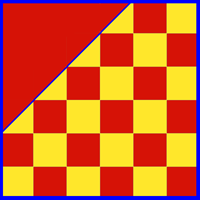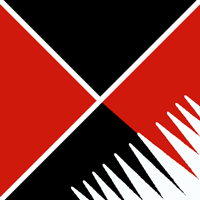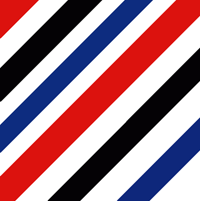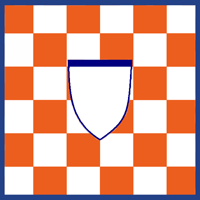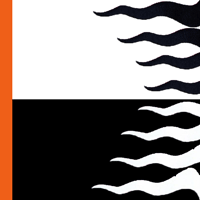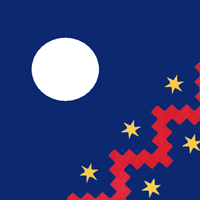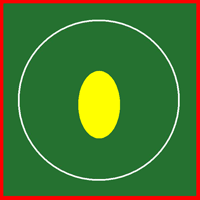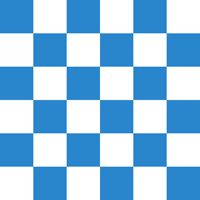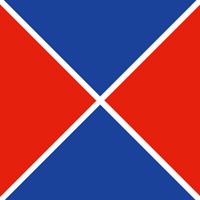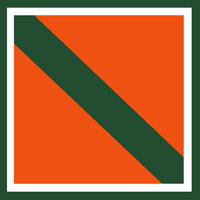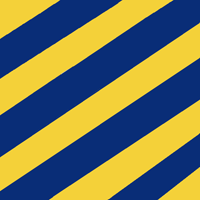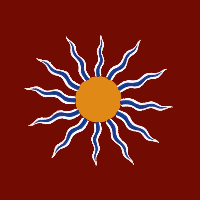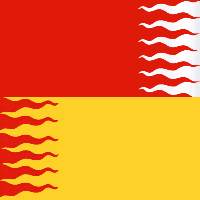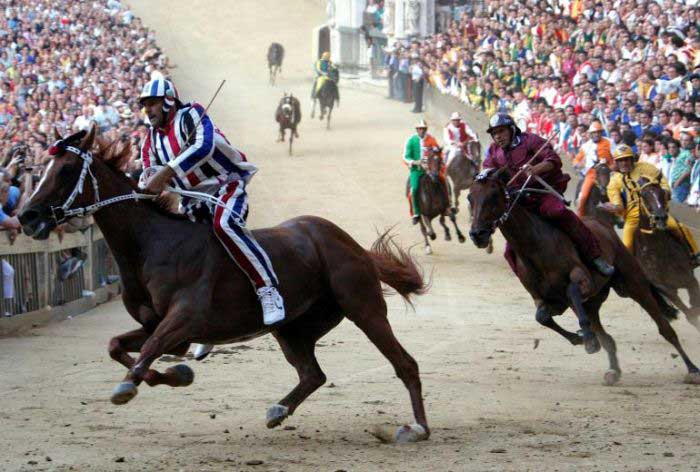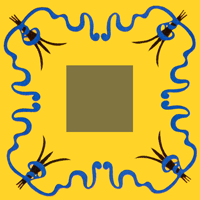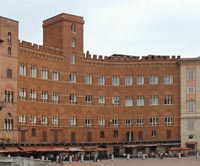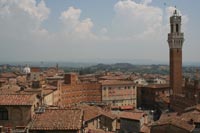| |
|
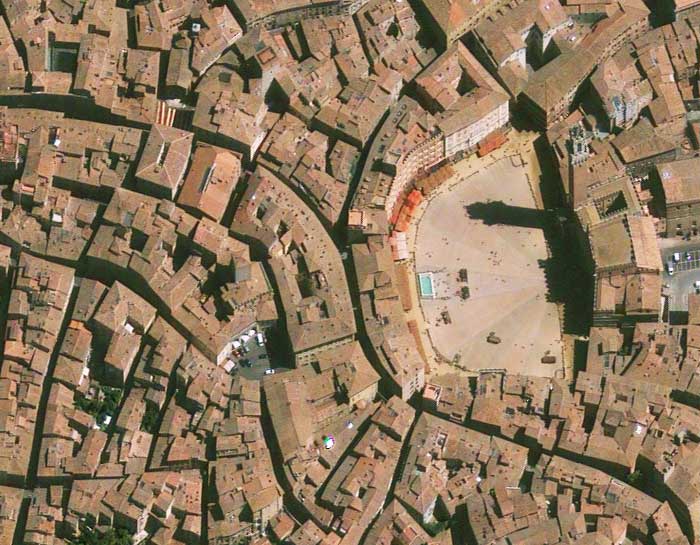 |
Siena, Piazza del Campo. GeoEye-1.50-meter resolution collected 15 August 2009
|
The Palio di Siena (known locally simply as Il Palio) is a horse race held twice each year on July 2 and August 16 in Siena, Italy, in which ten horses and riders, bareback and dressed in the appropriate colours, represent ten of the seventeen Contrade, or city wards. The Palio held on July 2 is named Palio di Provenzano, in honour of the Madonna of Provenzano, who has a church in Siena. The Palio held on August 16 is named Palio dell'Assunta, in honour of the Assumption of Mary.
A magnificent pageant, the Corteo Storico, precedes the race, which attracts visitors and spectators from around the world.
The race itself, in which the jockeys ride bareback, circles the Piazza del Campo, on which a thick layer of dirt has been laid, three times and usually lasts no more than 90 seconds. It is not uncommon for a few of the jockeys to be thrown off their horses while making the treacherous turns in the piazza, and indeed it is not unusual to see unmounted horses finishing the race without their jockeys.
Origins
The earliest known antecedents of the race are medieval. The town's central piazza was the site of public games, largely combative: pugna, a sort of many-sided boxing match or brawl; jousting; and in the 16th century, bullfights. Public races organized by the Contrade were popular from the 14th century on; called palii alla lunga, they were run across the whole city.
When the Grand Duke of Tuscany outlawed bullfighting in 1590, the Contrade took to organizing races in the Piazza del Campo. The first such races were on buffalo-back and called bufalate; asinate, races on donkey-back, later took their place, while horse-racing continued elsewhere. The first modern Palio (called palio alla tonda to distinguish it from the earlier palii alla lunga) took place in 1656.
A second Palio in August
At first, one race was held each year, on July 2, in honor of the Madonna di Provenzano [1]. A second, on August 16, was added from 1701, though initially the August race was run intermittently rather than every year. The August race (il palio dell'Assunta) which coincided with the Feast of the Assumption was probably introduced 'spontaneously' as part of the feasting and celebration associated with this important festival. The 16th of August was presumably chosen because the other days of the mid-August canonical festival, the 14th and 15th of the month, were already taken up respectively by the Corteo dei Ceri (Procession of the Ceri) and by the census.
The August Palio started out as an extension of the celebrations of the July Palio, and was organized and funded by July's winning contrada, though only if the contrada in question could afford it. After 1802, however, organisation and funding the August race became a central responsibility of the city, which removed annual uncertainty over whether or not an August Palio would run.
Restriction
In 1729 the city's Munich born governor, Violante of Bavaria, defined formal boundaries for the Contrade, at the same time imposing several mergers so that the number of Senese Contrade was reduced to seventeen. This was also the year of the decree restricting to ten the number of Contrade that could participate in a Palio: the restriction, which remains in force, resulted from the number and extent of accidents experienced in the preceding races.
Art in Tuscany | Siena
Art in Tuscany | Le Crete Senesi
|
| |
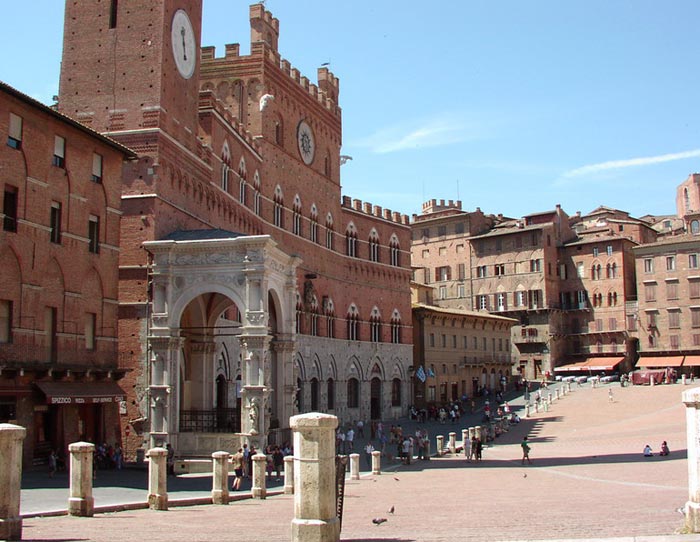 |
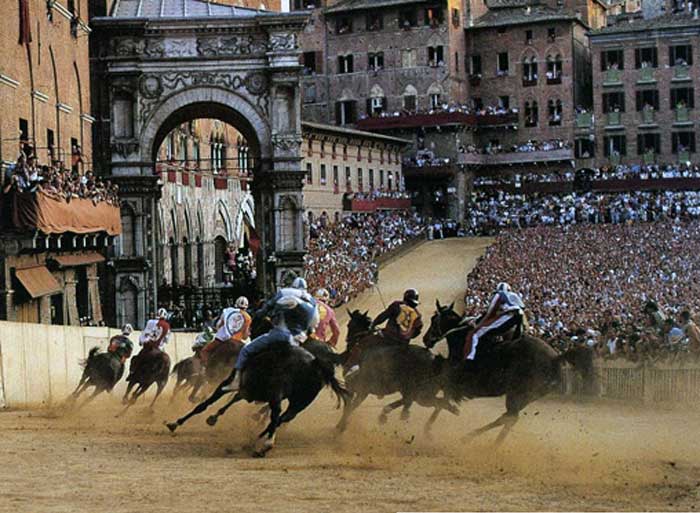
|
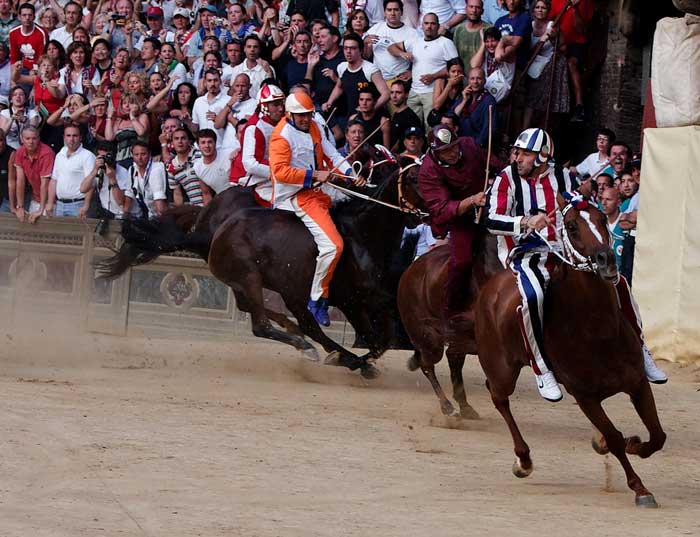
|
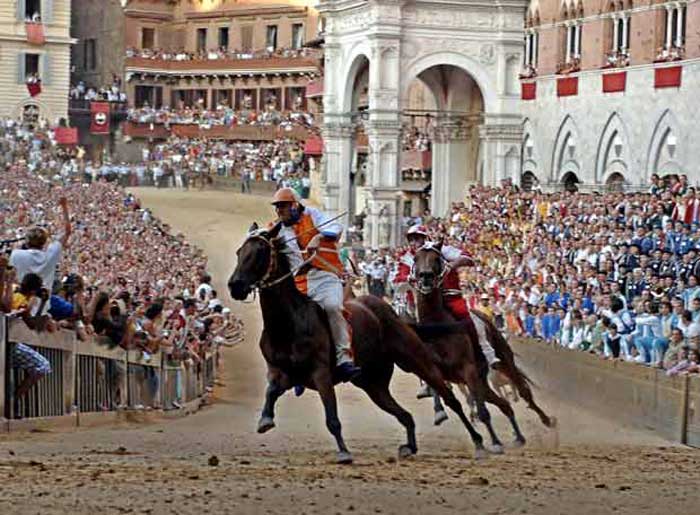
|
| |
Contrade of Siena
|
A contrada (plural: contrade) is a district, or a ward, within an Italian city. The most well-known contrade are probably the 17 contrade of Siena that race in the Palio di Siena. Each is named after an animal or symbol and each with its own long history and complicated set of heraldic and semi-mythological associations.
History
These districts were set up in the Middle Ages in order to supply troops to the many military companies that were hired to defend Siena as it fought to defend its independence from Florence and other nearby city states. As time has gone by, however, the contrade have lost their administrative and military functions and have instead become simply areas of localised patriotism, held together by the emotions and sense of civic pride of the residents. Their roles have broadened so that every important event – baptisms, deaths, marriages, church holidays, victories at the Palio, even wine or food festivals – is celebrated only within one's own contrada.
Every contrada has its own museum, fountain and baptismal font, motto, allied contrada (only Oca has no allies) and adversary contrada, typically a neighbor (only four, Bruco, Drago, Giraffa and Selva, have no declared adversaries). Often the adversary contrade share borders.
Abolished Contrade
There were originally 59 contrade, but consolidation over the centuries has seen the number reduced to today's 17. During the seventeenth century some contrade were slowly dying out until their abolition, which took place officially in 1729. These districts were: Gallo (Rooster), Leone (Lion), Orso (Bear), Quercia (Oak), Spadaforte (Strong Sword) e Vipera (Viper).
The reasons that led to the abolition of six quarters have always been surrounded by uncertainty. The deletion is traditionally traced to disorders related to the Palio of 1675, according to some because of Contrada Spadaforte (with support of five other Contrade), despite the victory of Lupa, recriminations for himself the victory, according to others it was Spadaforte forbidden to play for the Palio, it can not rely on its actual influence area.[1] The six "rebel" districts were therefore deleted.
In reality, the legend that the six quarters had been dissolved by law because of disturbances caused during the Palio of 1675 has no real foundation document. The reasons that led to the abolition of the six districts were mainly due to poor organization and lack of participation in public life of cities, evidenced in the book of Balia[2].
The six quarters were officially abolished the edict issued by Violante Beatrice of Bavaria (known as Notice of Violante of Bavaria) in 1729, which marked the boundaries of New Division Contrade still valid. These six were then incorporated into other contrade as follows;
* Gallo was incorporated into Civetta, Oca, and Selva.
* Leone was incorporated into Istrice.
* Orso was incorporated into Civetta.
* Quercia was incorporated into Chiocciola.
* Spadaforte was incorporated into Leocorno and Torre.
* Vipera was incorporated into Torre.
Today the six abolished contrade are remembered in the historical procession preceding the Palio di Siena: six riders with their helmets lowered, accompanied by a groom, parade in the ninth group of the Corteo Storico Historical Parade.
Siena contrade
|
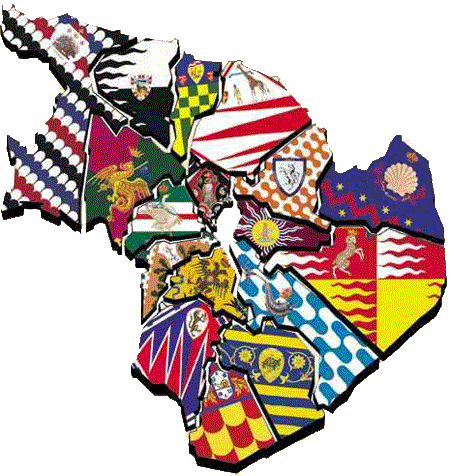
|
|
1 Aquila (Eagle)
2 Bruco (Caterpillar)
3 Chiocciola (Snail)
4 Civetta (Little Owl)
5 Drago (Dragon)
6 Giraffa (Giraffe)
7 Istrice (Crested Porcupine)
8 Leocorno (Unicorn)
9 Lupa (She-Wolf)
10 Nicchio (Seashell)
11 Oca (Goose)
12 Onda (Wave)
13 Pantera (Panther)
14 Selva (Forest)
15 Tartuca (Tortoise)
16 Torre (Tower)
17 Valdimontone (Valley of the Ram)
|
Map of the contrade of Siena, showing their respective banners
|
|
|
Aquila (Eagle)
|
|
|
| Aquila (Eagle) is situated immediately to the south-west of the Piazza del Campo in the centre of the city, and is home to the duomo (cathedral). Traditionally, its residents were notaries.
Their last victory was on July 3, 1992 (Andrea de Gortes on Vinegar on Floater) and they have had 24 official victories.
Aquila's symbol is a double-headed black eagle holding an orb, a sword and a sceptre. Its colours are yellow, trimmed with blue and black.
Aquila is one of only four nobile (noble) contrade; its title was bestowed by the Habsburg emperor Charles V, out of gratitude for the warm reception he received there in 1536.
The contrada's museum is home to the oldest surviving Palio di Siena banner (also called a palio), which dates from 1719.
Aquila's patron saint is La Vergine (the name of the Most Holy Maria), her titulary festival being celebrated on 8 September.
They are allied to the Civetta (Owl) and Drago (Dragon) contrade. They are opposed to the Pantera (Panther) contrada.
|
|
|
Bruco (Caterpillar)
|
|
|
| Bruco is situated to the north of the Piazza del Campo. Traditionally, its residents worked in the silk trade.
Bruco's symbol is a crowned caterpillar crawling on a rose. Its colours are green and yellow, trimmed with blue.
Bruco is one of only four nobile (noble) contrade; its title was earned in 1369 by its people's bravery in helping to defeat Charles IV, and consolidated in 1371 when they led the revolt to replace the Sienese council with a people's government.
Its Sede is at Via del Comune, 44.
Its patron Saint is Madonna (Visitation of the Saintest Mary) and the Titulary feast is on 2 July.
Its motto is "Come rivoluzion suona il mio nome" (How revolution sounds my name).
It is allied to the Istrice, Nicchio and Torre contrade and not officially opposed to any other contrade since its animosity with neighbouring Giraffa (giraffe) ended.
Last victory- 16 August 2008. It has 37 official Victories.
|
|
|
Chiocciola (Snail)
|
|
|
| Chiocciola is situated in the south-western corner of the city. Traditionally, its residents worked as terracotta makers.
Chiocciola's symbol is a snail. Its colours are red and yellow, trimmed with blue. Chiocciola's enemy is the Tortoise. Their last victory was on August 16, 1999. |
|
|
Civetta (Little Owl)
|
|
|
| Civetta is situated immediately to the north of the Piazza del Campo in the centre of the city. Traditionally, its residents were shoemakers.
Civetta's symbol is a crowned owl sitting on a branch. Its colours are red and black striped with white. Its motto is: "Vedo nella Notte" (I see in the night).
For years Civetta was considered the nonna (grandmother) because it had not won a palio for over 30 years. Civetta won the Palio in August 2009, thereby losing the name "nonna".
|
|
|
Drago (Dragon)
|
|
|
| Drago is situated to the north-west of the Piazza del Campo. Traditionally, its residents were bankers.
Drago's symbol is a flying golden dragon carrying a banner with the letter "u". Its colours are red and green, trimmed with yellow.
|
|
|
Giraffa (Giraffe)
|
|
|
| iraffa is an affluent area of the city situated to the north-east of the Piazza del Campo. Traditionally, its residents were painters.
Giraffa's symbol is a giraffe led by a Moor, and a ribbon bearing the motto "Humbertus I dedit" (Umberto I gave it"). Its colours are white and red.
Giraffa has the title of contrada imperiale (imperial contrada). It was bestowed this title by King Vittorio Emanuele III when it won the palio in 1936, the year the race was dedicated to Italy's empire in East Africa.
|
|
|
Istrice (Crested Porcupine)
|
|
|
| strice occupies the north-westernmost edge of Siena and contains the San Vincenzo e Anastasio church, home of the city's oldest surviving fresco and burial place of Pinturicchio.
Istrice's symbol is a porcupine. Its colours are red, white, blue and black.
Istrice has the title of contrada sovrana (sovereign contrada). It was bestowed this title as a result of it headquartering the Sovereign Military Order of Malta during the 14th century.
Istrice won the Palio in July 2008. |
|
|
Leocorno (Unicorn)
|
|
|
| Leocorno is situated to the east of the Piazza del Campo. Traditionally, its residents were goldsmiths.
Leocorno's symbol is a unicorn, rampant, with the motto "Humberti regio gratia" ("A kingdom by the grace of Umberto"). Its colours are orange and white, bordered with blue.
Leocorno won the Palio of August 16th 2007.
|
|
|
Lupa (She-Wolf)
|
|
|
| Lupa is situated to the north of the Piazza del Campo. Traditionally, the residents of Lupa were bakers.
Lupa's symbol is a female wolf nursing twins. Its colors are black and white, trimmed with orange. The she-wolf of this contrada refers to the legend that Siena was founded by Senius, the son of Remus who, along with his twin Romulus, was raised by a wolf. Because of this, Lupa's sister city is Rome.
The Lupa museum's prize exhibit is a photograph of Giuseppe Garibaldi, which he donated to the contrada on its victory in the Palio di Siena of 1867.
|
|
|
Nicchio (Seashell)
|
|
|
| Nicchio is situated in the far eastern corner of the city. Traditionally, its residents worked as potters.
Nicchio's symbol is a crowned scallop shell flanked by two branches of coral. Its colours are blue, with yellow and red trim.
Nicchio is one of only four nobile (noble) contrade; it earned its title for bravery shown during the Battle of Montaperti against Florence in 1260, when its soldiers led the attack.
|
|
|
Oca (Goose)
|
|
|
| Oca is situated just to the west of the Piazza del Campo. Traditionally, its residents made dyes.
Oca's symbol is a crowned goose wearing around its neck a blue ribbon marked with the cross of Savoy. Its colours are green and white, with red trim.
Oca is one of only four nobile (noble) contrade; it earned its title for its people's bravery during many battles fought by the former Sienese Republic.
The most recent palio win for Oca was in the July 2, 2007 race on Fedora Saura.
|
|
|
Onda (Wave)
|
|
|
| Onda runs south from the Piazza del Campo in the centre of the city. Traditionally, its residents were carpenters.
Onda's symbol is a dolphin. Its colours are white and sky blue and the condrada describes itself as "The colour of Heaven, the force of the sea"
Onda has the title of contrada capitana (captain contrada) because in the past its soldiers mounted guard at the Palazzo Pubblico. One of the famous members of Onda was the sculptor Giovanni Duprè, after whom the main street in Onda is named. Onda's adversary is Torre.
|
|
|
Pantera (Panther)
|
|
|
| Pantera is situated at the western edge of the city. Traditionally, its residents were grocers, chemists and Steamers.
Pantera's symbol is a rampant panther. Its colours are red, blue and white.
|
|
|
Selva (Forest)
|
|
|
| Selva runs west from the Piazza del Campo in the centre of the city. Traditionally, its residents were weavers, but when the contrade were mainly military they had a reputation for being excellent archers.
Selva's symbol is a rhinoceros at the base of an oak tree hung with hunting tools. Its colours are green and orange, bordered with white.
Winner of the Palio, on August 16 2006, with Salasso on Caro Amico. Won the Palio last on July 2, 2010, to much upset from Nicchio (favored to win).
|
|
|
Tartuca (Tortoise)
|
|
|
| Tartuca is situated at the southern end of the city. Traditionally, its residents were sculptors.
Tartuca's symbol is a turtle with alternating Savoy knots and daisies. Its colours are yellow and deep blue.
Winner of the Palio, on July 2 2009, with Giuseppe Zedde on Già del Menhir. Tartuca last won the Palio on 16 August 2010
It is opposed to Chiocciola (snail).
|
|
|
Torre (Tower)
|
|
|
| Torre is situated just to the south-east of the Piazza del Campo in the centre of the city, and encompasses Siena's Jewish quarter and synagogue. Traditionally, its residents worked as woolcombers.
Torre's symbol is an elephant (the contrada's original name was Liofante or Lionfante) with a tower on its back. Its colours are crimson, striped with white and blue.
Torre is the enemy of both Onda (wave) and of Oca (goose). It is the only contrada to have two enemies, making it the most contentious contrada in Siena.
|
|
|
Valdimontone (Valley of the Ram)
|
|
|
| Valdimontone is situated in the south-east of the city near Porta Romana. Traditionally, its residents were tailors.
Valdimontone's symbol is a crowned rampant ram, with a blue shield emblazoned with the letter "u" for Umberto. Its colours are red and yellow, with white trim.
It is allied with Onda (Wave) and opposed to Nicchio (Shell), its neighbour. |
|
|
| |
|
|
|
|
| |
|
The race today
The first race (Palio di Provenzano) is held on July 2, which is both the Feast of the Visitation and the date of a local festival in honour of the Madonna of Provenzano (a painting once owned by the Sienese leader Provenzano Salvani, which was supposed to have miraculous curative power). The second race is held on August 16 (Palio dell'Assunta), the day after the Feast of the Assumption, and is likewise dedicated to the Virgin Mary. After exceptional events (e.g. the Apollo 11 moon landing) and on important anniversaries (e.g. the centennial of the Unification of Italy), the Sienese community may decide to hold a third Palio between May and September. The most recent was in 2000 to mark the Millennium.
The field consists of ten horses, so not all seventeen contrade can take part in the Palio on any occasion. The seven contrade which did not take part in that month of the previous year are automatically included; three more are chosen by draw (twice a year, in the last days of May and at the beginning of July). Private owners (among them, some jockeys) offer the pick of their stables, selected during the year after trial races, other Palio races in Italy and veterinary examination, from which main representatives of the participating contrade, the Capitani, choose ten of approximately equal quality, three days before the race. A lottery then determines which horse will run for each contrada. Six trial races are run, the first on the evening of the horse selection and the last on the morning before the Palio. The devout residents of each contrada, known as contradaioli, invoke the sacred aid of their patron saint for their horse and jockey.
The worldly improve their odds with arguably dubious methods, chiefly bribery and doping. The sensible simply keep a close watch on their stable and their rider.
The horses are of mixed breed; no purebred horses are allowed.
The race is preceded by a spectacular pageant, the Corteo Storico, which includes (among many others) Alfieri, flag-wavers, in medieval costumes. Just before the pageant, a squad of carabinieri on horseback, wielding swords, demonstrate a mounted charge around the track. They take one lap at a walk, in formation, and a second at a gallop that foreshadows the excitement of the race to come, before exiting down one of the streets that leads out of Piazza del Campo. Spectators arrive early in the morning, eventually filling the centre of the town square, inside the track, to capacity; the local police seal the entrances once the festivities begin in earnest. Seats ranging from simple bleachers to elaborate box seats may be had for a price, but sell out long before the day of the race.
At 7.30 p.m. (July) / 7 p.m. (August), the detonation of an explosive charge echoes across the piazza, signaling to the thousands of onlookers that the race is about to begin. The race itself runs for three laps of the Piazza del Campo, the perimeter of which is covered with several inches of dirt, tuff (imported and laid for the occasion at great expense to the city), and the corners of which are protected with padded crash barriers for the occasion. The jockeys ride the horses bareback from the starting line, an area between two ropes. Nine horses, in an order only decided by lot immediately before the race starts, enter the space. The tenth, the rincorsa, waits outside. When the rincorsa finally enters the space between the ropes the starter (mossiere) activates a mechanism that instantly drops the canapo (the front rope). This process (the mossa) can take a very long time, as deals have usually been made between various contrade and jockeys that affect when the rincorsa moves - he may be waiting for a particular other horse to be well- or badly-placed, for example.
On the dangerous, steeply canted track, the riders are allowed to use their whips (in Italian, nerbi, stretched, dried bull's penises) not only for their own horse, but also for disturbing other horses and riders. The Palio in fact is won by the horse who represents his contrada, and not by the jockeys. The winner is the first horse to cross the finish line — a horse can win without its rider (a condition known as cavallo scosso). A horse can also win without its decorative headgear (spennacchiera), although the opposite belief is widely held even among the Sienese. The loser in the race is considered to be the contrada whose horse came second, not last.
The winner is awarded a banner of painted silk, or palio, which is hand-painted by a different artist for each race. The enthusiasm after the victory, however, is so extreme that the ceremony of attribution of the Palio is quite instantaneous, being the first moment of a months-long celebration for the winning ward. There are occasional outbreaks of violence between partisans of rival contrade.
There may be some danger to spectators from the sheer number of people in attendance. There have also been complaints about mistreatment of horses, injuries and even deaths, especially from animal rights associations and even from some veterinarians. In the Palio held on August 16, 2004 the horse for the contrada of Bruco (the Caterpillar) fell and was badly trampled as the race was not stopped, despite possible additional safety risks for other horses. The horse died of its injuries, raising further complaints from animal rights organizations, which do not recognize the municipality's efforts to improve the safety of the race and the exceptionality of that accident.
The Palio differs from "normal" horse races in that part of the game is for the wards to prevent rival contrade from winning. When a contrada fails to win, its historical enemy will celebrate the fact nearly as merrily as a victory of its own, regardless of whether adversarial interference was a deciding factor. Few things are forbidden to the jockeys during the race; for instance, they can pull or shove their fellows, hit the horses and each other, or try to hamper other horses at the start.
The most successful ward is Oca, the Goose, which has won 63 races (at least according to their records, which start from 1644), followed by Chiocciola, the Snail, with 51, and Tartuca, the Tortoise, with 46. Oca is also the contrada with the most wins in recent history (from 1900 to 2010) with 21 victories, followed by Selva, the Forest, with 18, and Drago, the Dragon, with 17.
Among jockeys, the most victorious of all time is Andrea De Gortes nicknamed "Aceto" (or "vinegar") with 14 wins (from 1964 to 1996), followed by Angelo Meloni, nicknamed "Picino", who won 13 times between 1897 and 1933. Luigi Bruschelli, nicknamed "Trecciolino", who is still active, is third in the number of wins with 12 successes.
The most successful horses were Folco and Panezio with 8 wins each, followed by Topolone with 7.
In recent history (from 1900 to the present), only two wards have ever succeeded in winning both the July and the August races in a single year (the term in Italian is "fare cappotto"). These are Tartuca (the Tortoise), which won both Palii in 1933, and Giraffa (the Giraffe) in 1997 with jockey Giuseppe Pes, nicknamed "Il Pesse".
Ritual and rivalry
The Palio di Siena is more than a simple horse race. It is the culmination of ongoing rivalry and competition between the contrade. The lead-up and the day of the race are invested with passion and pride. Formal and informal rituals take place as the day proceeds, with each contrada navigating a strategy of horsemanship, alliances, and animosities. There are the final clandestine meetings among the heads of the contrade and then between them and the jockeys. There is the two-hour pageant of the Corteo Storico, then all this is crowned by the race, which takes only about 75 seconds to complete. Although there is great public spectacle, the passions displayed are still very real.
There is also particular attention to the ward that has been the longest without a victory. In this case the contrada is nicknamed "nonna", or "grandmother". Civetta (the Owlet), had the title from 1979 until 2009, when it won the August 16 race. Torre, the Tower, had this title for being without victory for 44 years (from 1961 to 2005) and also Bruco, the Caterpillar, held the title for not winning over 41 years (from 1955 to 1996). The current "nonna" is Lupa (the She-Wolf), which has not had a victory since 2 July 1989, a period of 21 years, 255 days.
Palio (Drappellone)
The drappellone (banner), or palio, known affectionately as "the rag" in Siena, is the trophy that is to be delivered to the contrada that wins the Palio.
The palio is an elongated rectangular piece of silk, hand-painted by an artist for the occasion. It is held vertically on a black-and-white shaft halberd and topped by a silver plate with two white and black plumes draped down the sides.
The palio, along with the plumes, remains the property of the contrada. The plate is returned to the city of Siena before the two Palii of the following year, after the date and the name of the victorious contrada are inscribed on its back. There is one silver platter for the Palio in July and another for the August Palio. The plates are replaced approximately every ten years.
The value of the banner is unique, because it represents a particular historical period of the city of Siena. The palii often reflect the symbols of the various governments that have presided, at various times including the crest of the grand duchy of Lorraine, the crest of the Grand Dukes of Tuscany, the crest of the Kingdom of Savoy of Italy, symbols from Fascist Italy, and most recently imagery of the Republic.
The process that an artist should follow in designing the palio is rigid: it must follow a precise iconography that includes some sacred symbols, as the July Palio is dedicated to the Madonna of Provenzano, and that of August to the Madonna of the Assumption. It must present the insignia of the city, those of the third part of the city, and the symbols or colors of the ten contrade participating in the race. There are, however, no limits regarding the style of the art. The palio is first presented at a press conference in the courtyard of the Podestà of the City Hall about a week before the race.
The Palio runs throughout the year
Although many activities take place within each Contrada, the organization of the Palio is still the largest, since it is not just in two races each year. Each time, the festival itself runs for four days of intense rich and various events, the preparation of which lasts all year.
From early winter the leaders are talking and developing strategies, making contacts with the jockeys and horse owners. These prepare those who run in square or taking part in minor Palios (la cosiddetta provincia ) and bringing them to training courses organized by the city in the spring.
The full activities of the Palio start to grow in momentum towards the end of May, with the drawing of lots of the three remaining contrade that will join the seven that have won the right to race. With districts and teams outlined Contrade begin to talk about "deals" (engagement of jockeys) and "parties" (secret pacts for the win), despite the not knowing which horse that will be drawn in the lot.
About a week before the race the Palio (Drappellone) itself is presented to the City who has commissioned a local artist (in the case of the Palio of July) or internationally recognized (in the case of the Palio of August or a special Palio). Also at this time prior visits occur to where the horse will be presented for the lottery.
In the first of four days of festival the lottery is held, and subsequent combination of the Barbero (The term racehorse in the city of Siena and Tuscany) to districts in the race. The stone race track around the square is covered with a layer of dirt composed of a mixture of tuff, clay and sand. Six trials are run, during which the riders have the opportunity to better understand the behaviour of the horse that they have mounted and do get used to the square, its sounds and rhythms of the race. Although the trials are followed by many tourists and Contrada members in square, barriers are mounted on the outside of the track.
Among the events that mark the approach of the Palio are the rehearsal dinner, the "mass" of the jockeys, and the blessing of the horse and jockey.
The Extraordinary Palios
A The Extraordinary Palio is a third Palio which may take place during the period between May and September, and is associated with events or anniversaries of major importance for the community of Siena. Last extraordinary Palio coincided with the advent of the new millennium. It was actually held on 9 September 2000 and was won by Selva (Forest), by jockey Giuseppe Pes riding on The horse Urban II. Prior to this the last Palio extraordinary held on 13 September 1986 to celebrate the centenary of the abolition of the Balia and Biccherna governments.
In earliest times, the third Palio was a way to honor distinguished guests passing through or visiting Siena. An example is the extraordinary Palio of 7 June 1676, during the visit to Siena of the wife of Prince Don Agostino Chigi, or even that of 15 June 1673 (not considered official), honouring the visit to Siena of Cardinal Flavio Chigi. Even the Grand Duke of Tuscany requested another round of Palio, perhaps closer to the ordinary.
From the second half of 19th century extraordinary Palio's began to be organized for celebration of special events, rather than illustrious visits. This was the case of a meeting of the Society of Sciences, or the inauguration of important monuments (such as the inauguration of the monument to the fallen in the Battle of Curtatone and Montanara, on 29 May 1893). In 1896 they even ran four Palios, both ordinary and two extraordinary. The first race on 16 August which is considered extraordinary because it was requested by the citizens as the original race was moved to 25 August due to transfer from Siena's VIII Corps and the second on 23 September, for the inauguration of monument to Giuseppe Garibaldi.
A Third Palio was held in 1945, by popular acclaim to celebrate the end of World War II, the "Palio of Peace", won by Gioacchino Calabro riding Rubacuori su Folco, for the Contrada of Drago (Dragon). An extraordinary Palio was held in 1969 to commemorate the conquest of the Moon by the mission Apollo 11.
The following years created the habit of running on the occasion of a centenary of particular importance. This is the case of 28 May 1950, the fifth centenary of the canonization of St. Bernardine of Siena, or 5 June 1961 for the centenary of Unification of Italy.
Controversy and equine security measures
For several years, the Palio is the focus of numerous protests by animal rights organizations, including the Anti-Vivisection League, which includes primarily race incidents causing falls, which in some cases led to the death of the horse.
The results of calculations on the percentage of accidents caused by Palio vary depending on who makes them. The data that provides Anti-Vivisection League said that from 1970 to 2007 a total of 48 horses have died, 50% of fatal accidents per year, whereas those injured or killed during the race and then away from the cameras, both died during surgery. However, the calculations carried out by supporters of the Palio gives a rate of 2.05% of fatal accidents per ride, because of battery selection, testing and prizes if they play no less than ten per issue.
Another fact to consider is that many rules governing the protection of animals have been developed and implemented only since the nineties: the data, or animals or even supporters of the Palio, stress that the series has been drastically reduced after this date .
In recent decades the city of Siena has adopted a series of measures to ensure the protection of horses (and riders) before, during and after the race, but these measures are still judged insufficient by some animal welfare groups, who continue to seek ' abolition of the race. Among the measures taken include:
* Forecasting a compulsory health check, held by a commission appointed by the City Council and consists of two surgeons (including the City
* Serum chemistry analysis, introduced in May 1999 in order to confirm and verify what has always been required by the Rules, or the prohibition of administration of substances with stimulant and depressant, and local anesthetics,
* Approval in 1999 of the "Protocol for the provision of incentives for the maintenance of the Palio horse" and the establishment of the Register of horses trained to run continuously and Field. In 2004 introduced a register of farmers instead of half blood Arabian horses (deemed physically fit to travel) and a register of barriers;
* Building a track in town Mociano, identical in shape and slope to the Piazza del Campo. From March to June are held here, in addition to Monticiano and Monteroni d'Arbia, jobs and training courses required for horses that aims to take in the Palio,
* Protections (formerly known as materassoni) present the curve of St. Martin in June 1999 set up a barrier of protection to high absorption in PVC, raising the parapet of the House and the curve of shirts introduction of safety for the emergency personnel of 118,
* Intervention on the composition, method of implementation and monitoring of the layer of tuff
* Maintenance of horses that no longer run the Palio conditions (for age or injury) at the Equestrian Center of State Forestry "The Caggio" of the town of Radicondoli.
* Alcohol test for jockeys[16] as the order of the Secretary of Health Francesca Martini.
|

Tuscany is one of the most popular tourist destinations in the world. Known for its enchanting landscapes, its fantastic and genuine food and beautiful towns as Florence, Pisa, Lucca and Siena.
Podere Santa Pia is an enchanting Tuscan farmhouse, nestled in the vineyards and olive groves of the rolling Maremma hills. This privileged location offers a spectacular vista over the charming medieval town of Cinigiano and the entire Ombrone Valley. It is the perfect place for your relaxing holiday with your friends and family. The property consists of 4 large bedrooms furnished in a classic Tuscan style and 2 bathroom with shower, a big full-equipment kitchen with a fireplace and a big living room and dining room. With its original kitchen and the wood burning pizza oven, Podere Santa Pia offers an upbeat atmosphere. The farmhouse has been renovated and provided with all modern comforts (satellite TV, Wi-Fi Internet access, washing machine, dishwasher, and so on), with an eye to preserve the typical and charming elements of these rural lodgings. There you have, then, cosy and warm rooms with traditional terracotta-tiled floors, stone walls and wood-beamed ceilings. And the kitchen, furnished for pleasant meals with traditional Tuscan dishes (bread soup or "ribollita", tomato soup, "fettunta", Florentine-style steak, stewed wild boar, cinta senese cured meat, and other Tuscan specialities).
The impressive garden (9000 square mt.) allows you to enjoy a relaxing holiday and is perfect for taking time out and lounging about while sipping on a glass of local wines, Montecucco DOC and Brunello DOC.
Sitting in the garden, one can enjoy our dawns and dusks, with their jubilee of colours ranging from dark yellow to pink, orange and red. In this scenario, it is often possible to observe the flight of pheasants, falcons and buzzards, great tits, chaffinches and sparrows.
This is an enchanting place far from noise, ideal to regenerate body and mind, where one has the opportunity enjoy pleasant walks or rides on mountain bike. The summer breeze that caresses Podere Santa Pia guarantees "cool" holidays even in the hottest weather.
Tuscan farmhouses | Podere Santa Pia
|
| |
|
|
|
|
|
| |
|
|
|
|
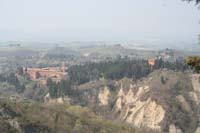
Monte Oliveto Maggiore abbey |
|
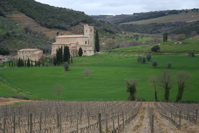
Abbey of Sant 'Antimo |
|
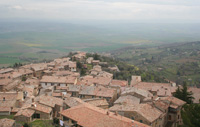
Montalcino |
| |
|
|
|
|
|
|
|
|
|
Siena, duomo |
|
Siena, Palazzo Sansedoni |
|
Siena, Piazza del Campo |
This page uses material from the Wikipedia article Palazzo Pubblico, Siena contrade and Palio di Siena, published under the GNU Free Documentation License.
|

[1]
The palio race commemorates the history of Italian cities as it has done so since the late Middle Ages. In the thirteenth century, the proliferation of feast days in Italian cities coincided with growth in population and commerce. The palio race was the culminating, profane event in a series of sacred offerings and processions, in which representatives of the city's and political groups participated. The palio may have descended from the chariot races held in Roman Italy for pagan festivals. The city government organized and paid for the palio. In Siena, the participation of the contrade (neighborhood groups) in the palio helped to preserve the tradition in the face of Florentine rule.
'The inception and evolution of devotion to the Madonna di Provenzano was an attempt by the sixteenth century Sienese to continue or perhaps capture the spirit of their ancestors. Although the inception and evolution of their devotion to the Madonna di Provenzano may have developed from latent civic identity that rumbled in the bellies of the no longer autonomous Sienese, the institution of the Palio in honor of the Provenzano has a slightly different, though connected, history. One might say that the institution of the tradition was the Medici’s reaction to Sienese resistance. By the mid-sixteenth century, the Sienese no longer had the power to institute or support their own civic feasts. The last feast the failing republic had managed to produce celebrated the city’s final victory over Florence, at the Battle of Camollia in 1526. Records show that this victory was celebrated annually with banquets and a palio on the feast of the Visitation, July 2 nd. Holding this celebration on a Marian feast day during the waning days of the Republic linked Siena’s latest victory to the city’s holy protectress, thus continuing the legacy of Montaperti and, again, claiming the glory of the thirteenth century city, even in the desperate days of the sixteenth. After the fall of the Republic, however, the Medici couldn’t have their fiefdom celebrating its own glory, especially if it was directly associated with Florence’s humiliation. Yet, even when the feast was renamed to merely celebrate the Visitation, its history remained intact. On the other hand, the Medici couldn’t completely abolish the feast without adding more fuel to the fire of those who openly resisted Mediciean rule and losing what little peace they had established in the newly enfeoffed Sienese. In order to maintain the air of order and appease their subjects, the Medici tried to reconcile the Sienese’s desire for the feast with their own traditions. At first they simply moved the celebration up a week, to the feast of St. John the Baptist, the patron saint of Florence, but imposing a new patron onto the Sienese did not work. Despite their dependent status, the Sienese stubbornly refused to give up their holy protectress. Thus the Medici were forced to find another focus for the July celebrations. The official recognition of the Madonna di Provenzano came just in time, perhaps hastened by Medici connections in Rome.'
Jenna Soleo-Shanks, RITUAL OF IDENTITY OR RENAISSANCE FAIR: THE POLITICAL HISTORY OF SIENA’S PALIO TRADITION, City University of New York, 2007, p. 19.
Piazza del Campo
History
The open site was a marketplace established before the thirteenth century on a sloping site near the meeting point of the three hillside communities that coalesced to form Siena: the Castellare, the San Martino and the Camollia. Siena may have had earlier Etruscan settlements, but it was not a considerable Roman settlement, and the campo does not lie on the site of a Roman forum, as is sometimes suggested. It was paved in 1349 in fishbone-patterned red brick with ten lines of travertine, which divide the piazza into nine sections, radiating from the mouth of the gavinone (the central water drain) in front of the Palazzo Pubblico. The number of divisions are held to be symbolic of the rule of The Nine (Noveschi) who laid out the campo and governed Siena at the height of its mediaeval splendour between 1292-1355. It was and remains the focal point of public life in the City. From the piazza, eleven narrow shaded streets radiate into the city.
The palazzi signorili that line the square, housing the families of the Sansedoni, the Piccolomini and the Saracini etc, have unified rooflines, in contrast to earlier tower houses — emblems of communal strife — such as may still be seen not far from Siena at San Gimignano. In the statutes of Siena, civic and architectural decorum was ordered :"...it responds to the beauty of the city of Siena and to the satisfaction of almost all people of the same city that any edifices that are to be made anew anywhere along the public thoroughfares...proceed in line with the existent buildings and one building not stand out beyond another, but they shall be disposed and arranged equally so as to be of the greatest beauty for the city."
The unity of these Late Gothic houses is effected in part by the uniformity of the bricks of which their walls are built: brick-making was a monopoly of the commune, which saw to it that standards were maintained. (Ingersoll)
At the foot of the Palazzo Pubblico's wall is the late Gothic Chapel of the Virgin built as an ex voto by the Sienese, after the terrible Black Death of 1348 had ended.
Fonte Gaia fountain
The magnificent Fonte Gaia fountain, designed by Jacopo della Quercia around 1419, adorns the higher part of Piazza del Campo. The fountain we see today stands on the exact spot occupied by a previously existing fountain in 1346. The water that feeds the fountain travels from a spring in the nearby countryside through 25 kilometres of underground passages known as Bottini, built in the Middle Ages and named thus on account of their barrel vaulting.
The fountain is named Fonte Gaia on account of the great celebrations that took place when the inhabitants of Siena saw the water gushing out from the fountain for the first time. Although Jacopo della Quercia received the commission to design the fountain from the Comune in 1409, construction did not actually take place until between 1414 and 1419 because of the sculptor’s prior engagements in Lucca, where he was completing the tombstones of Lorenzo Trenta and his wife in the Trenta family chapel at San Frediano in Lucca.
Della Quercia drew the inspiration for his design of the fountain from the traditional designs of Medieval Senese public fountains. A large, altar-like rectangular basin is surrounded on three sides by a high parapet. The sides are decorated with reliefs of The Creation of Adam and The Flight from the Garden of Eden. Two female figures adorn the front two columns, traditionally believed to represent Rea Silvia and Acca Larentia, in remembrance of Siena’s legendary associations with Rome. The long section of the fountain is adorned at the centre with a Madonna and Child, surrounded by allegories of the Virtues.
Although in poor condition, the sculptures are still a clear indication of the originality and power of Jacopo della Quercia, who has managed to capture an extraordinary sense of movement in so few simple lines.
By the mid-19th century the fountain was in such precarious condition that it was decided to replace the original with a copy. Tito Sarrocchi was commissioned to sculpt the new fountain in 1858 and he completed it in 1869, albeit without the two statues on the final pilasters. What remains of the original fountain by Jacopo della Quercia is kept in the Loggia of the Palazzo Pubblico.
Restoration works on the original fountain were started in the early 1990s, under the patronage of Florence’s Opificio delle Pietre Dure in collaboration with the Siena town council and the Sovrintendenze dei Beni Architettonici e Ambientali e Artistici e Storici di Siena. After a detailed analysis of the remaining parts, the project involves a piece by piece restoration, with the entire work eventually reassembled within a protected structure.
Palazzo Pubblico
The Palazzo Pubblico (town hall) is a palace in Siena, Tuscany, central Italy. Construction began in 1297 and its original purpose was to house the republican government, consisting of the Podestà and Council of Nine.
The outside of the structure is an example of Italian medieval architecture with Gothic influences. The lower story is stone; the upper crenelatted stories are made of brick. The facade of the palace is curved slightly inwards (concave) to reflect the outwards curve (convex) of the Piazza del Campo, Siena's central square of which the Palace is the focal point. The campanile or bell tower, Torre del Mangia, was built between 1325 and 1344 with its crown designed by the painter, Lippo Memmi. The tower was designed to be taller than the tower in neighboring rival Florence; at the time it was the tallest structure in Italy. It was fitted with a mechanical clock during the mid 14th century. Its design has been used as the basis for several other campaniles including the Dock Tower in Grimsby, England constructed in 1852 and the Joseph Chamberlain Memorial Clock Tower in the edgabston campus of the University of Birmingham (completed in 1908).
Frescoes
Nearly every major room in the palace contains frescoes. These frescoes are unusual for the time in that they were commissioned by the governing body of the city, rather than by the Church or by a religious fraternity. They are also unusual in that many of them depict secular subjects instead of the religious subjects which are overwhelmingly typical of Italian art of this era.
The most famous of the secular frescoes are three panels in the series on government in the Hall of the Nine (also known as Sala della Pace) by Ambrogio Lorenzetti. These frescoes are collectively known as Allegory and Effects of Good and Bad Government.
The Allegory of Good Government depicts the personification of Justice as a woman. She gestures to the scales of balance, held by the personifcation of Wisdom floating over her throne. On the viewer's left, a convicted criminal is beheaded; on the right, figures receive the rewards of justice. At Justice's feet, the personification of Virtue, also, unusually for the time, portrayed as a female figure, passes virtue among twenty four faithfully rendered and recognizable images of prominent male citizens of Siena. The men face towards the largest figure in the image, a judge located in the center right. The judge is surrounded by additional personifications including Peace, who is represented as a fashionable, white-clad contemporary female figure with elaborate blonde hair. (Then as now, blonde hair was fashionable and seldom entirely natural; it was not the dominant natural hair color for Italian women from this region, and it was common for women to lighten their hair by streaking it with urine and heating it in the sun.)
The allegory carries a strong social message of the value of the stable republican government of Siena. It combines elements of secular life with references to the importance of religion in the city at the time. The figure of Justice resembles the figure of Mary, Queen of Heaven, the patron saint of Siena, on a throne. The Judge reflects the tradition in the Christian Last Judgment to have God or Christ judging the saved on the left; the damned on the right. While classified as medieval or proto (pre)-renaissance art, these paintings show a transition in thought and an evolution in theme from earlier religious art.
Flanking the Allegory are two other paintings on perpendicular walls: Effects of Good Government and Effects of Bad Government. Both these frescoes depict a recognizable view of Siena and its countryside.
In the allegorical representation of Good Government, the prosperous townspeople are trading and dancing in the streets. Beyond the city walls is a lush countryside in which crops are harvested.
In the allegory of Bad Government, crime is rampant and diseased citizens roam a crumbling city. The countryside suffers from drought.
The Courtyard
Many of the frescoes in the Palace, including these, are badly damaged. This is allegedly due to salt once stored in the basement of the building. It is theoretically possible that the salts wicked moisture down from the walls, causing the plaster to dry excessively and the frescoes to flake off.
Other notable frescoes include the mysterious fresco of Guidoriccio da Fogliano at the siege of Montemassi, located in the Great Council Hall (Sala del Mappamondo). The fresco is traditionally attributed to Simone Martini, although there is debate on the subject. The wall has circular markings left by the circular wall-mounted (now lost) map of the world by Ambrogio Lorenzetti.
Siena was decimated by the Black Death in 1348. Approximately half the population died in the plague. The republic's economy was destroyed and the state quickly declined from its position of prominence in Italy. The Franciscan religious order rose to power in the city. The stagnation over the following centuries meant that while Siena did not develop during the Renaissance as did other Italian cities, it was also preserved both from bombardment during World War II and from modern development.
Palazzo Sansedoni
Of all the fine buildings that face onto Piazza del Campo, the red facade of Palazzo Sansedoni stands out distinctly. As well as being of major historical and artistic value, this building enjoys the added prestige of housing the Monte dei Paschi di Siena Foundation.
The palazzo takes its name from the Sansedoni family, one of Siena’s leading aristocratic dynasties during the Middle Ages. Probably the most eminent member of this family was Beato Ambrogio Sansedoni (Siena, April 16th 1220 – March 20th 1286), who was a major player on the political and social scene of 13th century Siena. After entering the Dominican order at just 17, Sansedoni studied alongside some of the most celebrated figures of his age, including St Thomas Aquinas and Pietro di Tarantasia, the future Pope Innocent V. His exceptional talents as a speaker and crowd-mover were admired across Italy and abroad as far as Germany and France. In what can only be termed an ironical twist of fate, Sansedoni died suddenly as he was writing one of his sermons. The city of Siena commemorated him with a bust inserted into the facade of the cathedral and until the mid-16th century there was a Palio specially dedicated to him. On July 2nd 1986 the vignettist Carlo Cerasoli featured Sansedoni on the Palio banner he designed for the occasion.
The unusual rhomboid tower, as well as the elegance with which the building curves to follow the square, marks Palazzo Sansedoni out from the other buildings that surround Piazza del Campo. The building has undergone a number of changes through the ages. Around the mid-13th century records indicate that a building stood here, probably a kind of tower residence. A document dated 1340 reads like a contract listing the design of a second building, while
the palazzo took on the appearance it has today after refurbishments carried out in the 18th century.
The interiors of the palazzo are the fruit of its 18th century refurbishments and particularly fine, from the fresco decorations by Melani and Ferretti to the fantastical architectural trompe l’oeils by Anderlini, sculptures by Mazzuoli and bronzes by Soldani and Foggini. The chapel of the Beato Ambrogio, also within the palazzo, is one of the finest examples of baroque style decoration in Siena. On the anniversary of the holy man’s death a mass is held here in the presence of all the city’s authorities.
A number of restoration works have been carried out on the palazzo in recent years, thanks to the Monte dei Paschi di Siena Foundation, with the aim of preserving and promoting what remains one of the city’s greatest Medieval buildings.
Art in Tuscany | Ambrogio Lorenzetti, Allegory and Effects of Good and Bad Government
|
|
|



